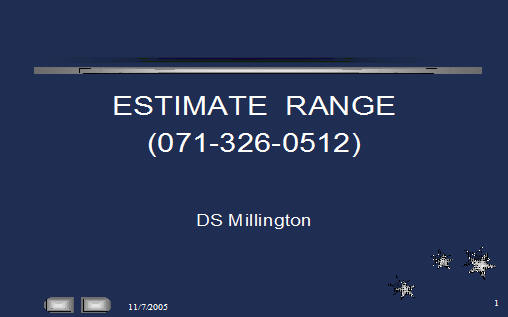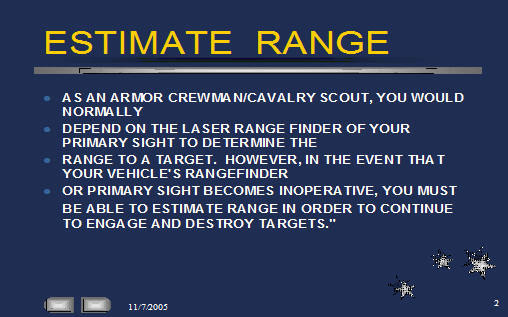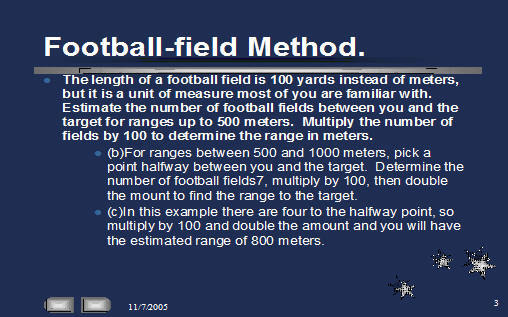Estimate Range
Click here to download the presentation.



ESTIMATE RANGE
(071-326-0512)
DS Millington
ESTIMATE RANGE
AS AN ARMOR CREWMAN/CAVALRY SCOUT, YOU WOULD NORMALLY
DEPEND ON THE LASER RANGE FINDER OF YOUR PRIMARY SIGHT TO DETERMINE THE
RANGE TO A TARGET. HOWEVER, IN THE EVENT THAT YOUR VEHICLE’S RANGEFINDER
OR PRIMARY SIGHT BECOMES INOPERATIVE, YOU MUST BE ABLE TO ESTIMATE RANGE IN ORDER TO CONTINUE TO ENGAGE AND DESTROY TARGETS.”
Football-field Method.
The length of a football field is 100 yards instead of meters, but it is a unit of measure most of you are familiar with. Estimate the number of football fields between you and the target for ranges up to 500 meters. Multiply the number of fields by 100 to determine the range in meters.
(b)For ranges between 500 and 1000 meters, pick a point halfway between you and the target. Determine the number of football fields7, multiply by 100, then double the mount to find the range to the target.
(c)In this example there are four to the halfway point, so multiply by 100 and double the amount and you will have the estimated range of 800 meters.
Factors which may affect target appearance.
Situations and conditions which may seem to make targets appear closer than they actually are:
a. Bright, clear day.
b. Sun in front of the target. The sun is behind you or over your shoulder as you are looking at the target.
c. High elevations. The target is at a higher elevation than you.
Factors which may affect target appearance.
d. Bright colors (white, red, yellow). The target is brightly colored.
h. Large targets.
i. Desert.
J. At sea
Factors which may affect target appearance.
Situations and conditions which may seem to make targets appear further away than they actually are:
a.Fog, rain, hazy twilight.
b. Sun behind the target.
c. Lower elevations.
d. Small targets.
e.Dark colors.
f.Camouflaged targets.
Recognition Method.
Although the situations and conditions just discussed will also have some effect on the Recognition Method, the data on this viewgraph will generally hold true. You should be able to identify armored and wheeled vehicles from 1,500 to 2,000 meters with the naked eye. If you can see the vehicle well enough to positively identify it as a tank but cannot determine the model, it is between 1,000 and 1,500 meters.
Flash-to-Bang method.
In this method, range is determined by counting the seconds between the time that you see the flash and when you hear the sound of the gun firing. You can count the seconds by counting one-thousand-one, one-thousand-two, and etc., with each count being one second. Since sound travels through the air at a speed of about 330 meters per second, each second you counted equals 330 meters.
Flash-to-Bang method.
To determine the range to a firing weapon, watch for the flash of the weapon when it fires and start counting seconds immediately. The number of seconds you count, multiplied by 330, will give you the approximate range from the target to your position. If you must count higher than ten seconds start over at one. The same method is used during hours of darkness.
Binocular-reticle/mil-relation method
For this method of range estimation you must know the mil measurement of the reticle in your binoculars and width, length, or height of the target, in meters, to figure range to the target.
Binocular-reticle/mil-relation method
(a) Mil Values.
(b) Known target size in meters. The average length of a threat tank is 6.7 meters and the average width is 3.4 meters.
Figuring the range.
1. Divide the known size of the target by the mil measurement from the reticle and multiply by 1000.
Example: 6.7 divided by 3 X 1000 =?; 3.4 divided by 2 X 1000 = ?.
2. Remember that after you divide the size of the target by the mil measurement you must multiply your answer by 1000 to determine the correct range, in meters, to the target.
QUIZ
1. When estimating the range using Flash-To-Bang method, what number do you multiply by to determine the range?
a. 370
b. 100
c. 330
d. 430
QUIZ
2. You observed the flash of a weapon firing and began counting. On the count of “ONE-THOUSAND-FIVE” you heard the weapon firing. What is the estimated range to the target?
a. 300 meters
b. 900 meters
c. 1500 meters
d. 1650 meters
QUIZ
3. You picked a point halfway between you and the target and determined the number of football fields was three. What is the estimated range to the target?
a. 600 meters
b. 1300 meters
c. 1200 meters
d. 1000 meters
QUIZ
4. You see a threat tank moving left to right across your front. He measures 4.0 mils in your binocular reticle. What is the range to the target?
a. 1625 meters
b. 2300 meters
c. 1675 meters
d. 2200 meters
QUIZ
5. You see a threat tank moving away from you. He measures 3.0 mils in your binocular reticle. What is the range to the target?
a. 2400 meters
b. 2600 meters
c. 2500 meters
d. 1133 meters
QUIZ
6. You determine that the number of football fields between you and the target is four. What is the estimated range to the target?
a. 200 meters
b. 300 meters
c. 400 meters
d. 500 meters
QUIZ
7. You observe the dust of a weapon firing and begin counting. On the count of “ONE-THOUSAND-SEVEN,” you hear the weapon firing. What is the estimated range to the target?
a. 2200 meters
b. 2310 meters
c. 2450 meters
d. 2400 meters
QUIZ
8. You picked a point halfway between you and the target and determined that the number of football fields was four. What is the estimated range to the target?
a. 800 meters
b. 950 meters
c. 1000 meters
d. 750 meters
QUIZ
9. You see a threat tank moving toward you. He measures 2.0 mils in your binocular reticle. What is the range to the target?
a. 1600 meters
b. 1800 meters
c. 1700 meters
d. 1900 meters
QUIZ
10. You see a threat tank moving right to left across your front. He measures 3.0 mils in your binocular reticle. What is the range to the target?
a. 2233 meters
b. 2500 meters
c. 2450 meters
d. 2320 meters
Estimate Range
ANY QUESTIONS?